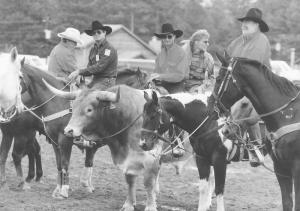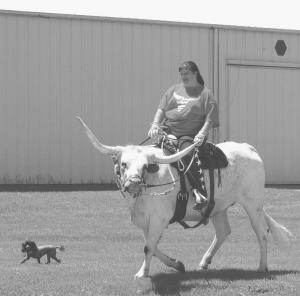2008 - Volume #32, Issue #2, Page #24
[ Sample Stories From This Issue | List of All Stories In This Issue | Print this story
| Read this issue]
Cattle-Riding "Cowboys" Catching On
 |
 |
"We've given out a lot of information over the years to our members," says Jauson King, founder of the association and keeper of the website that she started eight years ago. The $35 association membership covers the cost of a newsletter and access to an internet message board. Members also get access to equipment like nose bits for steers.
"We have 75 members in the U.S. and another 75 in Canada, Europe, Africa and Australia," she says. "Women make up about 75 percent of our membership."
Association members have done just about everything with their animals. One member in Texas does exhibition calf roping and team penning with his bull, while another Texas member does barrel racing with her steer. Some European members do English style jumping with their animals, which most often are cows instead of steers. North American members tend to prefer steers, explains King, though a California member rides and drives a Dexter cow.
The youth group includes members from all over the world. With their parent's permission, they receive web cams and mikes from the association, so they can see and talk to each other.
King, a former feedlot cowboy, started riding steers after recovering from a work related accident. She discovered that while riding a horse was painful, riding a steer was not a problem and had other benefits.
"Once they know what you want, there is no fight from them, no spooking or rearing and they break to halter easily," she says. "They learn quickly, and once you teach them something, you can put them in the pasture and leave them, and they will still be able to do the trick six months later."
The only problem, she admits, is that they can be lazy. "If you stop to talk, they'll just lay down," she notes.
Jauson says the cost of keeping a riding steer is about $700 per year less than keeping a riding horse, due to lower cost boarding, no shoeing and fewer disease concerns like West Nile. She also suggests that a riding steer can live into its 20's and can run, jump and trail ride just like horses. The one exception, she says, is they get more attention from other people.
Not all cattle make good riding animals, warns King. She recommends dairy over beef, although she says Longhorns often make the grade, too.
Another concern with riding steers is over feeding. King worked with Iowa State University and her feed dealer to come up with a good ration for riding cattle. "If a steer gets big and heavy, their knees blow out," she says. "If you have good conformation and keep the animal in shape, they will last."
This summer King will be holding the first ever training school for cattle riders. Classes will be personalized for attendees, but will include basic training skills, nutrition, hoof care, advanced riding and basic animal and equipment care.
Contact: FARM SHOW Followup, Jauson King, International Riding Steer Association, 603 B. Street, Corning Iowa 50841 (ph 641 322-4802; oneskyranch@gmail.com; www.ridingsteers.com; www.cattle-r-smart.com).

Click here to download page story appeared in.

Click here to read entire issue
To read the rest of this story, download this issue below or click here to register with your account number.




